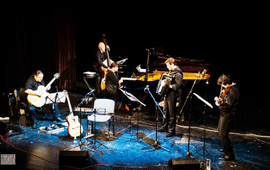> [Archived] Chronicles

Just Like That
In 2009 UNESCO certified tango as part of the world’s ‘intangible cultural heritage’. An impressive gesture that makes you seek the reasons why a partner dance, originated in the 1890s along the Rio de la Plata, the natural border between Argentina and Uruguay, soon spread to the entire world, becoming immortal. Hoping to find the answer to this issue, I attended a concert at the ArCuB Hall in Bucharest on Sunday, 20th October, at 20:00. The concert was given by Nuevo Tango Quintet from Timisoara (Alin Stoianovici – chromatic accordion, Lucian Petrilã - violin, Roxana Yvonne-Coºereanu - piano, Ion Dorobanþu - guitar, Johnny Bota – double bass) and their guest – the Argentinean artist Marili Machado; it was organized by the Instituto Cervantes in Bucharest and by Argentina’s Embassy in Romania.
The first part, exclusively instrumental, brought us works by Astor Piazzolla – the great creator of the Nuevo Tango style in the ‘50s, the one who tore down the conventional borders of the dance and, by mixing tradition with the modernity of the jazz improvisation and the technical achievements of the electronic instruments, opened up bold and generous pathways. The traditional quintet brings together bandoneon (this time chromatic accordion), violin, guitar, double bass and piano.
The five musicians from Timisoara, with different backgrounds, originating from different music worlds (from classical to jazz) managed not only to learn, but also to communicate in a new language whose complexity and depth are generated by its force of expression and emotional load, with an inexhaustible fantasy. The instrumental exercise and the rhythm of the composition make it difficult and challenging. I especially admired the virtuosity and brilliance of Alin Stoianovici’s accordion, but it would be unfair not to offer the same deserved appreciation to Johnny Bota’s double bass (the same Johnny Bota whose name and art will forever be connected with the famous Bega Blues Band), Lucian Petrilã’s violin, Ion Dorobanþu’s guitar (which, in my opinion, deserves a more prominent place, because I know he is perfectly able) or to Roxana Yvonne- Coºereanu’s piano. The five instrumentalists act as one, they are perfectly harmonized. The care for details regarding the rhythmical pulsation or the specific sonorities which sometimes turn the piano, the double bass and the violin into percussion instruments, is only a pillar of the arch that creates the image of the musical whole, a perfect illustration of the wise saying ‘all for one and one for all’.
The singer, guitarist and actress Marili Machado, born in Buenos Aires, studied singing at the famous Teatro Colón in Argentina’s capital and started her career in the ‘90s, interpreting both tango and Argentinean folklore. With a passionate temperament and totally lacking inhibitions, the artist lives with every song a complex story, full of meanings. The guitar and her stage performance manage to distract one from the weaknesses of a voice from which the interpreter requires more than she can get. However, her ability and efficiency in intelligently turning little imperfections into means of expression (only sometimes) deserve admiration.
The collaboration between the musicians from Timisoara and the singer arrived from Rio de Janeiro, with a collection of hits famous all over the world (among them: Invierno Porteño by Eladia Blásquez, Balada para un Loco by Horacio Ferrer and A. Piazzolla, Oblivión by Horacio Ferrer and A. Piazzolla, Siempre se Vuelve a Buenos Aires by Eladia Blásquez, Milonga de la Anunciación by H. Ferrer and A. Piazzolla…) turned out to be beneficial. In their interpretation, the tango, whether Argentinean or not, could only feel at home, as the Romanian musicians not only learned the rules of a foreign language (as wonderful as difficult), but managed to go beyond the written sign and enter, mentally and emotionally, the ineffable realm of poetry, where this dance has complete freedom, irrespective of place or time.
It was a wonderful evening, which made all of us feel beautiful and young. Just like that. Maybe these are as many answers to the question why Argentinean tango is now considered part of the world’s cultural heritage.
Translated by Mihaela Olinescu and Elena Daniela Radu
MTTLC, The University of Bucharest














